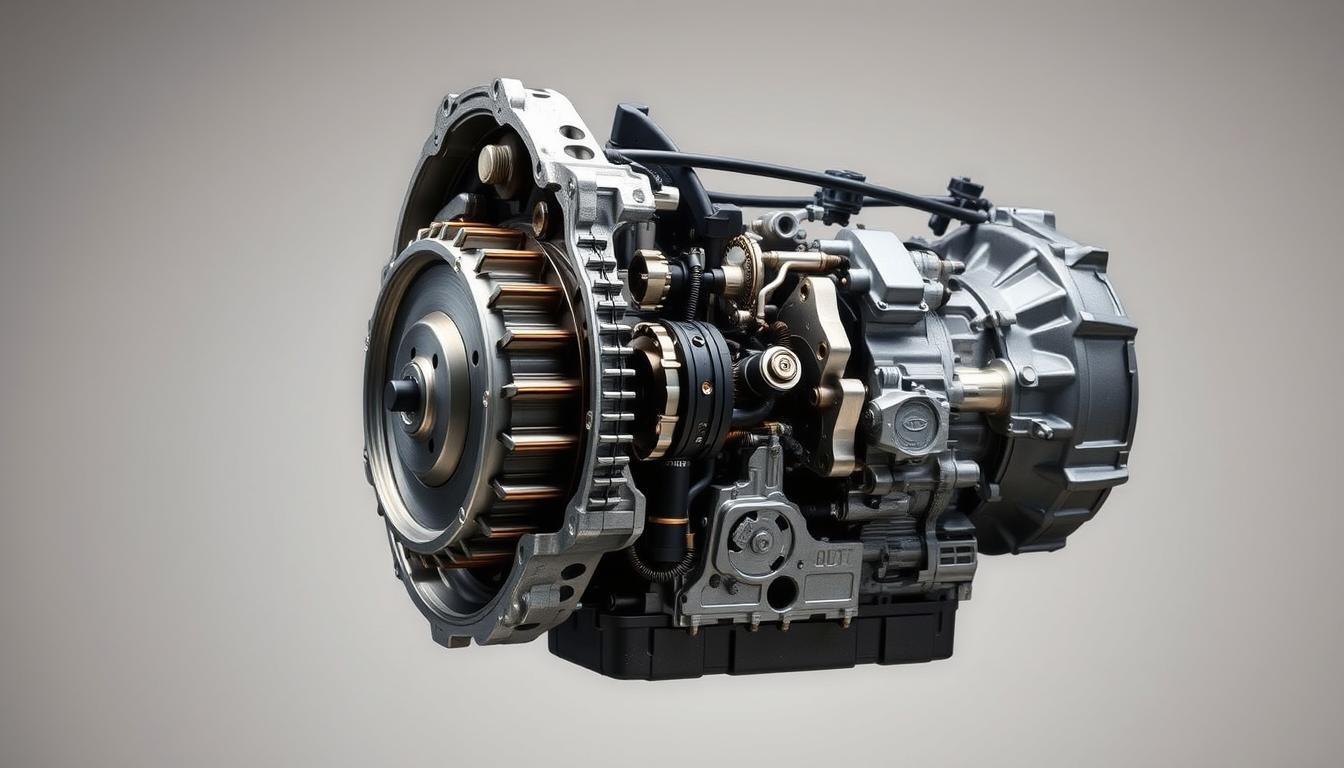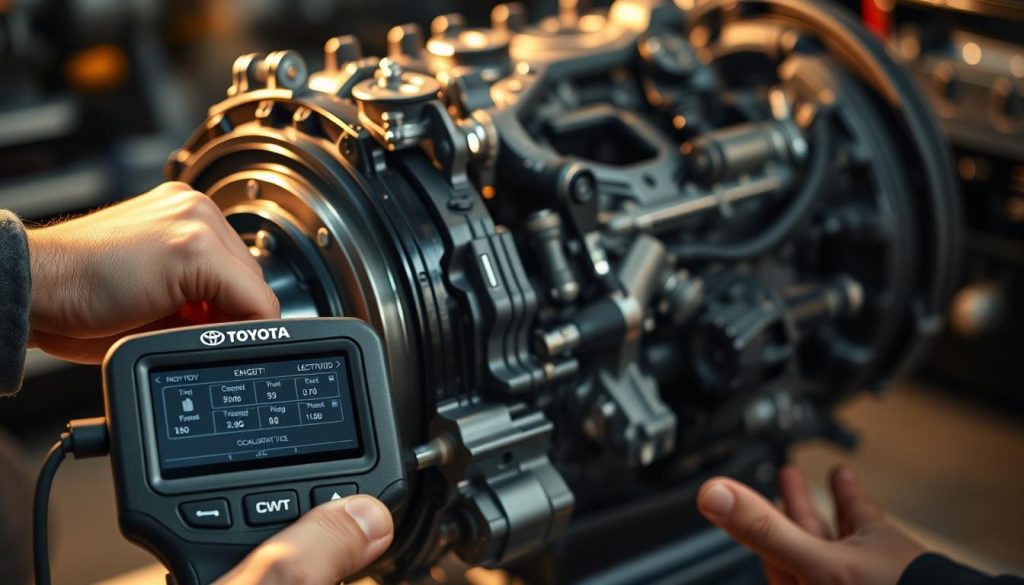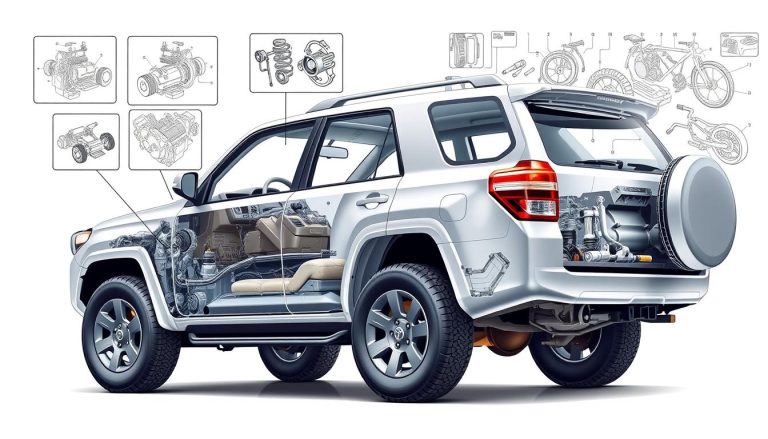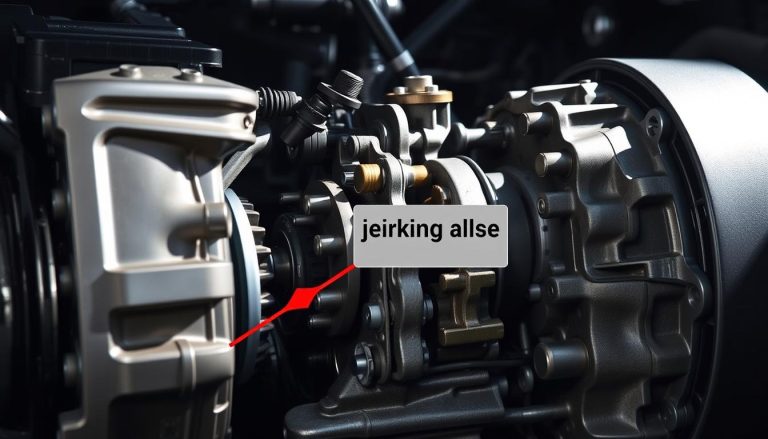Common Issues with Toyota CVT Problems | Insight
The Toyota CVT transmission is known for its innovative design and efficiency. But, it can sometimes face various issues. Problems like delayed acceleration, overheating, and unusual noises are common.
These issues often come from wear and tear on internal components, sensor failures, software glitches, and lack of maintenance. This article will guide you through troubleshooting these problems. It aims to keep your vehicle in top shape.
Understanding the Toyota CVT Transmission
CVT technology is a big change in how cars use power. It uses a belt and pulley system instead of fixed gears. This allows for an endless range of gear ratios.
What is a CVT?
A CVT doesn’t have fixed gears. It has two pulleys that change size and a flexible belt. This lets the engine run at its best speed for any driving situation.
How Toyota Implements CVT Technology
Toyota uses CVT in many models, like the Corolla. It makes the car perform better. Toyota’s CVT systems make driving smooth and responsive.
This tech also makes cars more fuel-efficient. It’s good for the driver and the planet.
Advantages of a Toyota CVT Transmission
Toyota CVT helps cars use less fuel. It keeps the engine running efficiently. This means better gas mileage.
CVT also makes cars accelerate smoothly. You won’t feel the usual shifts of old automatics. This makes driving more comfortable and fun.
These benefits make Toyota CVT a great choice for today’s drivers. It offers efficiency and a better driving experience.
Delayed Acceleration in Toyota CVTs
Understanding delayed Toyota CVT acceleration is key. We’ll explore the issues and maintenance tips to help you fix these problems.
Identifying the Symptoms
Spotting delayed acceleration in your Toyota CVT is the first step. Look for a lag when you press the accelerator. You might also notice uneven power and slow performance when speeding up.
Common Causes
Several factors can cause delayed acceleration in Toyota CVTs. These include:
- Worn CVT belts
- Low transmission fluid levels
- Software issues within the CVT system
Knowing these causes helps you diagnose and fix the problem quickly.
Potential Fixes
After finding the cause, the right maintenance can fix it. Here are some solutions:
- Update the CVT software to the latest version – this fixes software glitches.
- Check and top up transmission fluid levels – this boosts performance.
- Replace worn CVT belts – this fixes mechanical issues causing delays.
By following these tips, you can make your vehicle more responsive and drive smoother.
Overheating Issues in Toyota CVT Transmissions
Overheating can seriously damage Toyota CVT transmissions if not fixed quickly. Knowing the signs and causes is key to solving the problem.
Signs and Symptoms
Signs of an overheating Toyota CVT include a burning smell and dashboard warning lights. You might also hear strange noises like whining or grinding. In bad cases, the transmission might slip or go into “limp” mode to protect itself.
Why Overheating Occurs
There are several reasons for overheating in Toyota CVT transmissions. Driving in heavy loads or mountains puts extra stress on them. Old transmission fluid also loses its cooling and lubricating abilities. A weak cooling system can make things worse, causing overheating.
Solutions for Overheating
When your Toyota CVT overheats, act fast to avoid more damage. Here are some solutions:
- Allow the Transmission to Cool: Stop driving and let the vehicle cool down for a while. This often helps reduce the temperature to acceptable levels.
- Change the Transmission Fluid: Regularly changing the transmission fluid can prevent overheating and ensure optimal performance.
- Upgrade the Cooling System: Enhancing the transmission’s cooling capacity by installing an auxiliary cooler can be highly effective, even in tough driving conditions.
Knowing how to address overheating in Toyota CVT transmissions can make your car last longer. It also makes driving smoother and more reliable.
Unusual Noises from Toyota CVT Transmissions
Many Toyota owners hear strange noises from their CVT transmissions. These sounds can be scary and make you worry. Knowing what these noises mean can help fix problems and make your CVT more reliable.
Types of Noises
Drivers often hear high-pitched whining, humming, or rattling from their CVT transmissions. These sounds can point to different problems:
- Whining: This might mean worn-out bearings or low fluid levels.
- Humming: It could be a sign of CVT belt or pulley issues.
- Rattling: Loose parts or wear inside the CVT might cause this.
Diagnostic Methods
To find and fix unusual noises in Toyota CVT transmissions, try these steps:
- Fluid Analysis: Check the transmission fluid for contamination or wear. This can help find the source of the noise.
- Component Inspection: Look closely at CVT parts like belts and pulleys. This can show if they need to be replaced.
Mechanical Fixes
After finding the cause of the noise, fix it with the right mechanical steps. This will solve Toyota CVT transmission problems and boost reliability:
- Bearing Replacement: Replacing damaged bearings can stop whining noises.
- Fluid Replenishment: Keeping the right fluid levels and quality can reduce humming and prevent damage.
- Component Tightening or Replacement: Fixing or replacing loose or worn parts can stop rattling noises.
By listening to these noises and fixing them quickly, you can make your Toyota CVT transmission last longer and work better.
Shuddering and Jerking During Acceleration
Feeling your Toyota shudder and jerk when you accelerate can be scary. This usually happens when parts of the CVT system wear out or don’t work right.
Recognizing Shuddering and Jerking
Shuddering feels like a vibration or tremble. Jerking is a noticeable jolt or stutter. You might see these problems when you speed up quickly or start moving after stopping.
Possible Causes
There are a few reasons why this might happen:
- Old or dirty CVT fluid
- Clutches in the transmission that are worn out
- Problems with the CVT belt or pulleys
- Glitches in the transmission control module’s software
How to Address These Issues
To fix these problems, you might need to do one or more of the following:
- Fluid Changes: Switching to new CVT fluid can make your car run smoother.
- Clutch Replacements: If clutches are worn out, replacing them can stop the jerking.
- Mechanical Inspections: Checking the CVT belt and pulleys regularly can catch and fix problems early.
- Software Updates: Sometimes, updating the transmission control module can fix shudder and jerking caused by software issues.
Fixing these problems quickly can make your car easier to drive. It also helps your transmission last longer, solving the jerking issue.
Transmission Slipping in Toyota CVTs
Many car owners worry about Toyota CVTs slipping. This section covers symptoms, causes, and fixes for slipping CVTs. It’s packed with tips for keeping your car running smoothly.
Symptoms of Slipping
Transmission slipping can make your engine rev up but not move faster. It feels like your car is losing grip. You might also see sudden speed changes or slow acceleration.
Common Factors Behind Slipping
Several things can cause Toyota CVTs to slip. Here are a few:
- Low fluid levels: Not enough transmission fluid can cause slipping because of poor lubrication and cooling.
- Worn belts: Over time, belts inside the CVT can wear out. This makes them less effective at transferring power.
- Sensor malfunctions: Bad sensors can send wrong signals to the transmission control module. This can lead to slipping.
Repair Options
Fixing a slipping CVT has several solutions. Here are a few:
- Fluid replacement: Keeping transmission fluid at the right level can solve slipping problems.
- Belt replacement: Replacing old belts is key to getting your CVT working right again.
- Sensor recalibration: Making sure sensors are working right or replacing them can greatly improve your car’s performance.
Knowing the signs of CVT problems and how to fix them is important. It helps keep your car’s transmission in top shape. This ensures a smooth and reliable drive.
Toyota CVT Problems
It’s important to know about Toyota CVT problems to keep your car running well. These transmissions are known for being efficient and smooth. But, they can face issues like delayed acceleration, overheating, and unusual noises.
Spotting Toyota CVT problems early can help you figure out what’s wrong. For example, strange noises might mean there’s a mechanical problem. Overheating often happens when the transmission doesn’t cool down properly or gets too much strain.
Delayed acceleration is a big worry for many Toyota owners. It can be caused by worn-out parts or issues with the transmission fluid. Shuddering and jerking when you accelerate can also happen if parts are damaged or not well-lubricated.
Transmission slipping is another serious issue. It makes your car feel like it’s losing power while driving. Knowing about these problems helps you take better care of your car and fix it on time.
Here’s a quick look at some common Toyota CVT problems:
| Problem | Symptoms | Common Causes | Potential Solutions |
|---|---|---|---|
| Delayed Acceleration | Slow response when accelerating | Worn-out parts, fluid issues | Component replacement, fluid check |
| Overheating | High temperature readings | Poor cooling, excessive strain | Cooling system check, reduce strain |
| Unusual Noises | Clicking, whining sounds | Mechanical issues, wear and tear | Inspection, mechanical repair |
| Shuddering/Jerking | Vibrations, jerking motions | Internal parts, lubrication problems | Part replacement, improve lubrication |
| Transmission Slipping | Loss of power mid-drive | Worn components, fluid degradation | Component replacement, fluid maintenance |
Diagnosing Common Toyota CVT Problems
When your Toyota CVT has issues, knowing how to diagnose them is key. The right steps and tools can save you time and money. It’s all about finding the problem quickly and efficiently.
Using Onboard Diagnostic Tools
Onboard diagnostic tools are a great way to find out what’s wrong. They read error codes that tell you about your transmission’s health. Here’s how to use them:
- Connect the OBD-II scanner to your vehicle’s port, usually under the dashboard.
- Turn on the ignition without starting the engine.
- Read the error codes and look up a Toyota CVT troubleshooting guide.
The Role of Transmission Fluid
Transmission fluid is vital for your CVT’s health. Keeping it clean and at the right level is essential. Here’s what to do:
- Check the fluid level with the dipstick.
- Look at the fluid’s color and consistency; it should be clear and reddish.
- See your vehicle’s manual for the right transmission fluid type.
The Toyota CVT diagnostic guide stresses the importance of fluid levels. It helps you troubleshoot effectively.
When to Consult a Professional
Some problems you can fix yourself, but others need a pro. If you see:
- Persistent transmission slipping or odd noises.
- Same error codes after checking the fluid.
- Overheating warnings or shuddering when you accelerate.
Use this Toyota CVT troubleshooting guide to know when to call a mechanic. It’s the best way to keep your vehicle running smoothly.
Routine Maintenance for Toyota CVT Transmissions
Keeping your Toyota CVT transmission in top shape is key. A regular maintenance schedule helps avoid problems and keeps your car running well. Here are some important Toyota CVT maintenance tips for your routine.
Regular Fluid Changes
Changing the CVT transmission fluid regularly is a must. Toyota’s service guides suggest doing this at set intervals. It keeps the transmission running smoothly and prevents overheating.
Clean transmission fluid is vital for lubrication and cooling. It also helps reduce wear and tear on the transmission’s parts.
Inspecting and Replacing Components
Checking and replacing worn-out parts is also essential. Look out for belts, pulleys, and sensors. Regular checks can spot problems early, preventing big repairs later.
| Component | Recommended Inspection Interval | Replacement Guidelines |
|---|---|---|
| Belts | Every 30,000 miles | Replace if any wear or damage is detected |
| Pulleys | Every 60,000 miles | Replace if misalignment or excessive wear is found |
| Sensors | Every 30,000 to 60,000 miles | Clean or replace if malfunctioning |
The Importance of Software Updates
Modern Toyota CVT transmissions rely on software for their performance. Keeping your software up to date is vital. It fixes known issues and improves how the transmission shifts, leading to better fuel efficiency.
Always check your Toyota CVT service guide for the latest software updates. This ensures your vehicle runs at its best.
Toyota’s Technical Service Bulletins (TSBs) for CVTs
Toyota CVT TSBs are key to keeping your car running well. They tell technicians and owners about known CVT problems. They also offer fixes to solve these issues.
What Are TSBs?
TSBs are detailed reports from car makers about common issues in certain models. For Toyota CVTs, they highlight problems and suggest fixes. Unlike recalls, TSBs deal with less urgent issues that don’t risk safety but affect performance.
Notable TSBs for Toyota CVTs
Over the years, Toyota has released many TSBs for CVT issues. For example:
- Transmission fluid updates to prevent unnecessary wear
- Software updates to fix shifting delays
- Component replacements to address shuddering issues
These TSBs have greatly reduced common CVT problems. They help drivers enjoy smoother and more reliable rides.
How to Access TSB Information
Getting to Toyota CVT service bulletins is easy. Just use the Toyota Technical Information System (TIS) website. You can search for TSBs for your car model there. Staying updated with these bulletins helps you fix issues early.
Impact of Driving Conditions on Toyota CVT Performance
Your driving conditions can greatly influence Toyota CVT performance. Knowing how different scenarios affect your CVT can help you take preventive measures. This way, you can avoid any future issues.
Effect of Heavy Loads
Toyota CVTs handle varying weights well. But, driving with heavy loads often can stress the transmission. This is because heavier loads put more strain on the CVT, leading to faster wear and tear.
To reduce this stress, try to lighten your cargo whenever you can. Also, check your vehicle’s manual for the recommended load limits.
High-Stress Driving Environments
Driving in stressful environments, like hilly terrains or heavy traffic, can cause Toyota CVT performance issues. Steep inclines make the transmission work harder, leading to overheating and other problems. Stop-and-go traffic also causes frequent shifts and wears down the CVT components faster.
To ease these stresses, follow some Toyota CVT driving tips. Try to maintain a steady pace and avoid sudden stops and starts. This can help your CVT perform better.
Preventive Measures
To keep your Toyota CVT in top shape, follow these preventive measures:
- Regularly monitor and adjust your driving habits based on conditions.
- Make sure your transmission fluid is clean and at the right level.
- Schedule routine maintenance checks to catch any early signs of trouble.
By following these Toyota CVT driving tips, you can extend your transmission’s lifespan. This will also improve your vehicle’s overall performance.
Software Recalibration for Better CVT Functionality
To keep your Toyota’s continuously variable transmission (CVT) at its best, consider recalibration. This process updates the transmission’s software. It makes the car more responsive and efficient. Let’s explore how this works and its advantages.
Adjustments Made through Software Updates
Today’s cars can get Toyota CVT software updates. These updates change how the CVT works. They make the transmission control module better match your driving style and ensure smooth shifts. By updating the CVT, your car can handle wear and tear better, possibly avoiding expensive repairs.
Benefits of Recalibration
Recalibrating your Toyota CVT through software updates offers many benefits:
- Enhanced Fuel Efficiency: Tweaks to the software can make your car use less fuel.
- Smoother Acceleration: New software means faster and smoother power delivery.
- Extended Transmission Life: Correct recalibration reduces stress on the transmission, making it last longer.
When to Consider a Recalibration
Think about a Toyota CVT software update if you notice your car’s performance is off. This includes slow acceleration, frequent gear changes, or after big repairs. Your mechanic might also suggest it during regular check-ups to prevent problems.
Proper Transmission Fluid for Toyota CVTs
Choosing the right transmission fluid is key for your Toyota CVT’s health and performance. There are different types of Toyota CVT fluid, each designed for CVTs. They ensure your CVT works smoothly and lasts longer.
Types of CVT Fluid
The main types of Toyota CVT fluid are Toyota Genuine CVT Fluid FE, Toyota Genuine CVT Fluid TC, and Toyota Genuine Fluid WS. Each is made to work best in different driving situations. Always use the right fluid for your Toyota to avoid problems.
Signs of Fluid Degradation
It’s important to watch for signs that your fluid is breaking down. Look for odd noises, lower fuel efficiency, and slow gear changes. If the fluid looks or smells bad, it’s time for a change.
The Role of Fluid Additives
Fluid additives are important for your Toyota CVT’s performance. They cut down on friction, stop oxidation, and keep the fluid’s viscosity right. Choosing fluids with good additives helps your CVT run smoothly and last longer.
Transmission Hardware Issues and Inspections
Fixing problems with Toyota CVT hardware is key to keeping your car running well. Regular checks can spot issues early, saving you from expensive fixes later. It’s important to look at the drive belt, pulleys, and control valves. These parts are vital for a CVT to work smoothly.
Toyota CVTs need precise parts to perform well. Wear and tear can cause slipping, strange noises, and slow starts. Spotting these problems needs detailed inspections, using both the eyes and special tools.
Start by checking the transmission fluid. If it’s dirty or off-color, it might mean something’s wrong inside. Also, check the drive belt and pulleys for wear. If they’re damaged, replace them quickly to avoid more problems.
Using tools like onboard diagnostics (OBD) can find error codes and show if parts are failing. This is key to knowing what’s wrong and how to fix it.
Here’s a table showing common problems with CVT parts and how they affect your car:
| Component | Common Issues | Impact on Performance |
|---|---|---|
| Drive Belt | Wear, Tension Loss | Slipping, Reduced Efficiency |
| Pulleys | Misalignment, Wear | Unusual Noises, Jerky Movements |
| Control Valves | Sticking, Blockage | Delayed Shifting, Poor Acceleration |
Regular checks and knowing about common issues can keep your CVT running smoothly. This not only makes your car last longer but also makes driving better.
Understanding Toyota CVT Recalls and Service Campaigns
Knowing about Toyota CVT recalls and service campaigns is key for your vehicle’s safety and performance. Recalls deal with safety issues ordered by law. Service campaigns, on the other hand, are Toyota’s own efforts to fix non-safety problems or enhance performance.
How Recalls Differ from TSBs
Technical Service Bulletins (TSBs) are guidelines for dealers to fix known issues that don’t affect safety but might impact performance or longevity. Unlike TSBs, Toyota CVT recalls are official orders to fix safety defects that could risk the vehicle’s safe operation. Dealers must follow recalls, but TSBs are just suggestions.
Recent Recall Examples
Recent Toyota CVT recalls show how critical it is to address safety concerns. For example, a recall for the Toyota Corolla was due to the CVT’s pulley and belt wearing out too fast. This could cause a loss of transmission power, posing a safety risk. Such recalls are enforced to ensure all affected vehicles are fixed quickly.
Steps to Take if Your Vehicle is Affected
If your Toyota is recalled, acting fast is important. Here’s what to do:
- Check the National Highway Traffic Safety Administration (NHTSA) website for recall info using your Vehicle Identification Number (VIN).
- Contact your local Toyota dealership to book a repair appointment.
- Follow the instructions from the dealership or Toyota’s service campaigns to get your vehicle fixed right.
Options for Repair and Replacement
Choosing between repairing or replacing a Toyota CVT can be tough. It’s important to know when to fix it and when to replace it. This helps car owners make the best choice for their vehicle.
When to Repair
Fixing a Toyota CVT is a good idea for small problems. These include fluid leaks, worn parts, or software issues. These fixes are usually quicker and cheaper:
- Fluid leaks can often be fixed by replacing seals and gaskets.
- Worn-out parts might need just a few replacements, not a full overhaul.
- Some issues can be solved with software updates or recalibration.
When to Replace
Replacing a Toyota CVT is needed for major damage or when repairs cost too much. Look out for these signs:
- Complete failure of the transmission.
- Recurring problems that can’t be fixed.
- Big damage to important parts inside.
Cost Considerations
Several things affect the cost:
- Extent of Damage: Small fixes are cheaper, but big damage costs more.
- Parts and Labor: Prices for parts and labor vary, affecting the total cost.
- Warranty Status: Cars under warranty might have costs covered, saving money.
By considering these points, drivers can decide wisely. They can choose between fixing or replacing their Toyota CVT. This choice helps balance their budget and the car’s lifespan.
Warranty and Coverage for Toyota CVT Issues
If you have problems with your Toyota CVT, knowing your warranty is key. Toyota usually offers a 5-year or 60,000-mile warranty for the powertrain. This should cover major transmission issues, giving you peace of mind.
But, not every problem is covered. Wear and tear or damage from bad maintenance might not be included. It’s smart to know the details of your warranty. This way, you can figure out what repairs or replacements are covered.
If you have an extended warranty, or Vehicle Service Agreement (VSA), you get more protection. This plan covers more issues, so you won’t face unexpected costs.
To get the most from your warranty, keep your car in good shape. Regular maintenance, as Toyota suggests, keeps the CVT working well. This might also stop problems that aren’t covered by warranty.
If you’re unsure about your warranty or coverage, reach out to Toyota’s customer service or your local dealer. They can help clear up any confusion and guide you through the claim process.
Conclusion
In our detailed Toyota CVT troubleshooting guide, we covered many topics. We looked at issues like slow acceleration, overheating, and strange noises. These problems are key to keeping your Toyota CVT running well.
Regular maintenance is vital. It includes changing fluids and checking the system often. By doing this, you can avoid many problems. Also, keeping up with software updates and knowing about recalls helps a lot.
When issues pop up, using diagnostic tools and getting expert advice is smart. This way, you can find and fix problems quickly. Taking care of your Toyota CVT is more than just fixing things as they break. It’s about being proactive and keeping your car in top shape.
By following the advice in this guide, you can make your Toyota CVT more reliable. This will improve your driving experience. Being informed and proactive is the best way to keep your Toyota CVT system running smoothly.
FAQ
What are common Toyota CVT problems?
Toyota CVTs often face issues like delayed acceleration and overheating. You might also hear unusual noises, feel shuddering, or notice jerking. These problems can stem from wear, sensor failures, software bugs, or neglect in maintenance.
What is a CVT?
A CVT, or Continuously Variable Transmission, doesn’t use physical gears. It uses a belt and pulley system. This setup offers a wide range of gear ratios, boosting fuel efficiency and ensuring smooth starts.
How does Toyota implement CVT technology?
Toyota uses CVT in models like the Corolla to boost fuel economy. It ensures power delivery is seamless. This technology helps in achieving better fuel efficiency and smoother acceleration than traditional automatics.
How can I identify delayed acceleration in a Toyota CVT?
Delayed acceleration shows as a lag when pressing the gas pedal. It could be due to worn belts, low fluid, or software problems.
What are the signs of Toyota CVT overheating?
Overheating CVTs might smell like burning and show warning lights. High loads and old fluid are common causes. Cooling the transmission, changing the fluid, and improving cooling can help.
What unusual noises might indicate Toyota CVT transmission issues?
Sounds like high-pitched whining or rattling might mean worn bearings or low fluid. Fluid analysis and component checks can find the problem. Replacing bearings might fix it.
What causes shuddering and jerking during acceleration in Toyota CVTs?
Shuddering and jerking can be due to old CVT fluid or worn clutches. Changing the fluid and replacing clutches might solve the problem.
What are the symptoms of transmission slipping in a Toyota CVT?
Slipping transmission shows as engine revving without moving. Causes include low fluid, worn belts, and sensor issues. Replacing fluid and recalibrating sensors can help.
How do onboard diagnostic tools help with Toyota CVT issues?
Diagnostic tools can read error codes to pinpoint CVT problems. This helps in fixing issues early and deciding if professional help is needed.
Why are regular maintenance routines important for Toyota CVTs?
Regular care, like fluid changes and inspections, prevents common CVT issues. It also extends the transmission’s life.
What are Technical Service Bulletins (TSBs) for Toyota CVTs?
TSBs are advisories from Toyota for CVT concerns, like software bugs and wear. They’re available through the Toyota Technical Information System (TIS).
How can driving conditions affect Toyota CVT performance?
Heavy loads and tough terrains stress CVTs. Proper loading and careful driving can reduce wear and keep performance up.
What is the benefit of software recalibration for Toyota CVTs?
Recalibration improves CVT’s response and efficiency. It’s recommended after repairs or if you notice lagging acceleration.
How important is using the correct transmission fluid for Toyota CVTs?
The right transmission fluid is key for CVT performance. Degraded fluid causes unusual noises and slipping. Fluid additives can also improve performance and longevity.
How do Toyota CVT recalls differ from TSBs?
Recalls fix safety issues and are mandatory at no cost. TSBs address common, non-safety issues. Check the NHTSA recall website for updates.
What factors should be considered when deciding between repairing or replacing a Toyota CVT?
Consider the damage extent, part costs, and warranty status. These factors help decide between repair or replacement.











